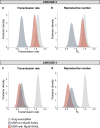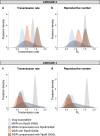The relative transmission fitness of multidrug-resistant Mycobacterium tuberculosis in a drug resistance hotspot
- PMID: 37031225
- PMCID: PMC10082831
- DOI: 10.1038/s41467-023-37719-y
The relative transmission fitness of multidrug-resistant Mycobacterium tuberculosis in a drug resistance hotspot
Abstract
Multidrug-resistant tuberculosis (MDR-TB) is among the most frequent causes of death due to antimicrobial resistance. Although only 3% of global TB cases are MDR, geographical hotspots with up to 40% of MDR-TB have been observed in countries of the former Soviet Union. While the quality of TB control and patient-related factors are known contributors to such hotspots, the role of the pathogen remains unclear. Here we show that in the country of Georgia, a known hotspot of MDR-TB, MDR Mycobacterium tuberculosis strains of lineage 4 (L4) transmit less than their drug-susceptible counterparts, whereas most MDR strains of L2 suffer no such defect. Our findings further indicate that the high transmission fitness of these L2 strains results from epistatic interactions between the rifampicin resistance-conferring mutation RpoB S450L, compensatory mutations in the RNA polymerase, and other pre-existing genetic features of L2/Beijing clones that circulate in Georgia. We conclude that the transmission fitness of MDR M. tuberculosis strains is heterogeneous, but can be as high as drug-susceptible forms, and that such highly drug-resistant and transmissible strains contribute to the emergence and maintenance of hotspots of MDR-TB. As these strains successfully overcome the metabolic burden of drug resistance, and given the ongoing rollout of new treatment regimens against MDR-TB, proper surveillance should be implemented to prevent these strains from acquiring resistance to the additional drugs.
© 2023. The Author(s).
Conflict of interest statement
The authors declare no competing interests.
Figures






References
-
- O’Neill J. Tackling drug-resistant infections globally: final report and recommendations. Wellcome Trust & HM Government, UK (2014).
-
- World Health Organization. Global tuberculosis control - surveillance, planning, financing. WHO (2022).
Publication types
MeSH terms
Substances
Grants and funding
LinkOut - more resources
Full Text Sources
Research Materials

